What Is Agriculture And What Are Agricultural Practices
Growing plants and rearing animals for food, clothing, and other useful products is called agriculture. Plants of the same kind grown on a large scale for food, clothing, etc., are called crops. For example, several plants of maize grown in a large field form a crop of maize. Examples of food crops are cereals (e.g., rice, wheat, and maize), pulses (e.g., urad, arhar, and mung bean), fruits (e.g., mango, apple, and banana), and vegetables (e.g., spinach, potato, and onion).
Based on the growing season, the crops grown in India can be classified as kharif and rabi. Kharif crops are generally planted in June and harvested in October. Rice, maize, cotton, and groundnut are examples of kharif crops.
Rabi crops are generally planted in November and harvested in April. Wheat, barley, pea, and gram are examples of rabi crops.
Agricultural Practices
For growing crops, farmers perform a series of activities, in a particular sequence, over a period of time. These activities are known as agricultural practices.
The major steps involved in this process are-
- Preparation of soil
- Selection and sowing of seeds
- Irrigation
- Weeding and Crop Protection
- Harvesting
- Storage

Soil Preparation
Soil is the main medium in which plants grow. Roots of plants absorb water, air, and vital nutrients from soil. In order to ensure that these are readily available to the roots, the soil is ‘prepared’ before growing a crop. Soil preparation involves ploughing, levelling, and applying fertilizers.
Ploughing The process of loosening and turning the soil is called ploughing or tilling. This process is important because of the following reasons.
- It allows the roots to reach deeper into the soil. This helps to fix the plant more firmly to the ground.
- It helps in trapping air in the soil, which is necessary for roots to ‘breathe’.
- It helps the soil to retain moisture for a longer duration.
- It helps in bringing nutrient-rich soil to the top.
- It helps the soil to mix well with fertilizers.
- It helps in the removal of undesirable plants called weeds.
Organisms like earthworms also help in ‘ploughing’ the field, as their burrowing action helps in loosening and turning the soil. These organisms also help in the decay of dead plants and animals in the soil. This process leads to the formation of a substance called humus, which is rich in nutrients for plants.
Soil is ploughed with the help of a tool called plough. Plough and other tools needed for large-scale production of crops are called agricultural implements. Ploughs are drawn either by bullocks or other animals like horses and camels or through a tractor. A plough can be made of wood or iron.
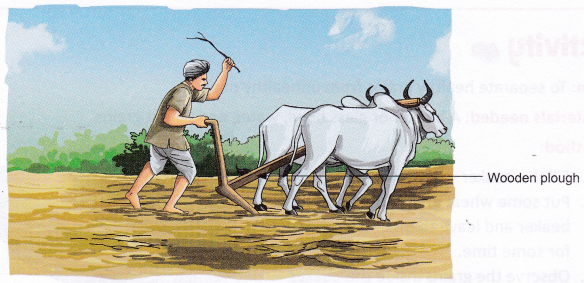
Nowadays, implements called cultivators, which are driven by tractors, are increasingly being used for ploughing. This saves both time and effort.
Levelling Even after ploughing, big lumps of soil (called crumbs) may remain in the field. These are crushed using wooden or iron planks called levellers and this process is called levelling.
Applying fertilizers When crops are grown in a field, they absorb nutrients from the soil. After growing many crops in the same field, the level of nutrients in the soil may decrease as they are being used up by the crops. Eventually, the soil may even turn infertile (i.e., not allow growth of crops at all). To avoid this situation, farmers often add substances called fertilizers to the soil. Fertilizers are natural or chemical substances that contain one or more nutrients essential for plant growth. Fertilizers can be natural or chemical.
Natural fertilizers | Chemical fertilizers |
| 1. These are natural substances obtained from plant and animal wastes. | 1. These are chemical substances produced in factories. |
| 2. These increase the humus content of the soil. | 2. These do not increase the humus content of the soil. |
| 3. These are not very rich in absorbable plant nutrients. | 3. These are very rich in absorbable plant nutrients. |
| 4. Examples are manure, compost, bone meal (a mixture of crushed and coarsely ground bones), and bark of neem. | 4. Examples are urea, ammonium sulphate, potash, and NPK (nitrogen, phosphorus, potassium) fertilizers. |
Chemical fertilizers may get washed into water bodies through a process called leaching and harm fish and other aquatic animals. Their overuse should, therefore, be avoided.
Selection and Sowing of Seeds
Selecting good-quality, healthy seeds is the next important part of crop production. In India, a government body called the National Seeds Corporation (NSC) is involved in the production of good quality agricultural seeds. NSC has also helped in setting up seed-testing laboratories in different parts of the country.
Activity
Aim: To separate healthy grains from unhealthy ones
Materials needed: A beaker or glass bowl, water, and wheat grains
Method:
- Fill the beaker with water.
- Put some wheat grains in the beaker and leave them undisturbed for some time.
- Observe the grains inside the beaker.

Observation: Some grains settle down at the bottom of the beaker while some float on the surface of the water (see figure).
Conclusion: Grains that have been damaged by insects tend to be lighter and float on the surface. Healthy grains are heavier and settle down at the bottom.
After the seeds have been selected, they need to be sown in the field. Sowing is the process of placing seeds in the soil. The following points must be kept in mind while sowing seeds. Seeds should be sown at appropriate distance from one another. Overcrowding may result in competition for air, sunlight, and nutrients among the young plants that emerge from these seeds. Such competition is harmful for the young growing plants. Seeds should be sown at the correct depth, neither too shallow nor too deep. Sowing can be done manually (i.e., by hand) or with the help of an implement called seed drill.
Manual sowing This process (also called broadcasting) involves direct sprinkling of seeds into the soil. Seeds sown in this manner are distributed unevenly (which may result in overcrowding). Also, this method may not ensure that all seeds are sown at the correct depth.
Using a seed drill A seed drill can be pulled across the field using bullocks or a tractor. Seeds sown using a seed drill are distributed evenly and placed at the correct depth in the soil.
Irrigation
Seeds sown in the soil require water for their growth. Water requirements differ from crop to crop. For instance, paddy needs a constant supply of water whereas wheat requires water at regular intervals. Rainfall is one of the sources of water for crops. As one cannot always depend on rainfall, other ways of supplying water to crops have been devised. Irrigation refers to artificial application of water to the soil for assisting the growth of crops.
Water for irrigation is obtained from wells, rivers, lakes, reservoirs, and tube wells. Methods of irrigation can be considered under two broad categories: traditional and modern.
Traditional methods: Canal irrigation, furrow irrigation (Fig. 1.3), chain pump, moat (pulley system), dhekli, and rahat (water wheel) are some of the traditional methods of irrigation. These methods are cheaper, but often lead to wastage of water.
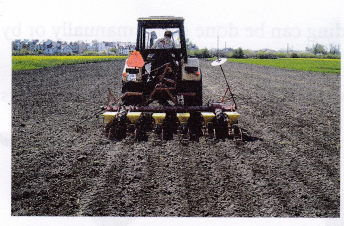
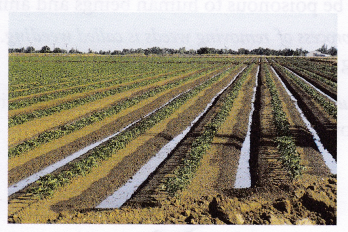
Modern methods: Sprinkler irrigation and drip irrigation are examples of modern methods of irrigation. These methods help in saving water. Care must be taken not to water the field excessively. Excess water on the field may cause a condition called waterlogging, which may harm the crops by decreasing the amount of air available to the roots and leading to an increase in the salt content of the soil.
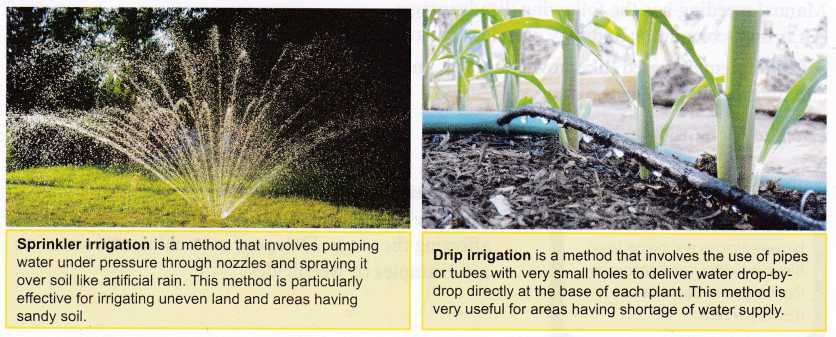
Weeding and Crop Protection
Sometimes, undesirable plants called weeds grow along with the crop. Amaranthus (chaulai), wild oat, grass, and Chenopodium (bathua) are examples of weeds. Weeds need to be removed as they start competing with the crops for air, sunlight, and nutrients. Some of them may even be poisonous to human beings and animals. The process of removing weeds is called weeding. Weeding can be done either manually or by using chemicals called weedicides.
Manual weeding Weeds can be uprooted either by hand or with the help of implements like harrow, trowel, and hoe.

Manual weeding has the following disadvantages.
- It is time-consuming and may even lead to accidental removal of desired crops.
- The implements used (like trowel, harrow, and hoe) are made of iron and need regular maintenance to prevent rusting.
Using weedicides A weedicide is a chemical that is used to destroy weeds. Weedicides destroy the weeds without affecting the crops. Dalapon, metachlor, and siziazine are examples of weedicides.
Animals like rats and insects also damage crops. Such animals are called pests. Most pests can be destroyed by using chemicals called pesticides.
Weedicides and pesticides have the following disadvantages.
- Accidental contact with these chemicals may adversely affect the health of farmers.
- Traces of these poisonous chemicals may remain in crops themselves, which can be very harmful to human life. It is, therefore, very important to wash grains and vegetables thoroughly before consumption.
Harvesting

The process of cutting and gathering of crops is called harvesting. Harvesting of cereal crops is either done manually, with the help of a sickle, or with the help of a machine called harvester. After harvesting, grains of cereal plants are separated from the rest of the plant. This is done by threshing and winnowing.
Threshing is done either manually, or with the help of a machine called thresher. A machine called combine harvester can be used for both harvesting and threshing. Winnowing, which involves the separation of the grain from chaff (seed coverings and tiny pieces of leaves or stem), can be done manually, or using a winnowing machine.
Storage
Harvested grains need to be stored before they are made available for consumption. To prevent their spoilage, it is necessary to ensure that both the grains and the storage area are free of moisture. The grains are dried in the sun to remove as much moisture as possible. They are then weighed and packed in gunny bags or bins. Bulk storage of grains is done in granaries and silos.
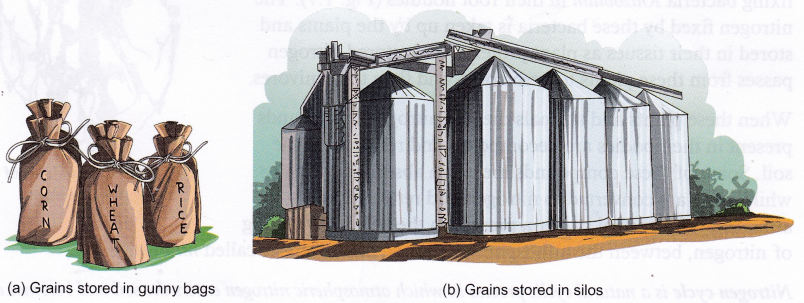
The storage area should be kept clean and dry. Pesticides should be sprayed beforehand to keep away pests. Periodic inspection of the storage area is necessary to ensure the safety of grains.